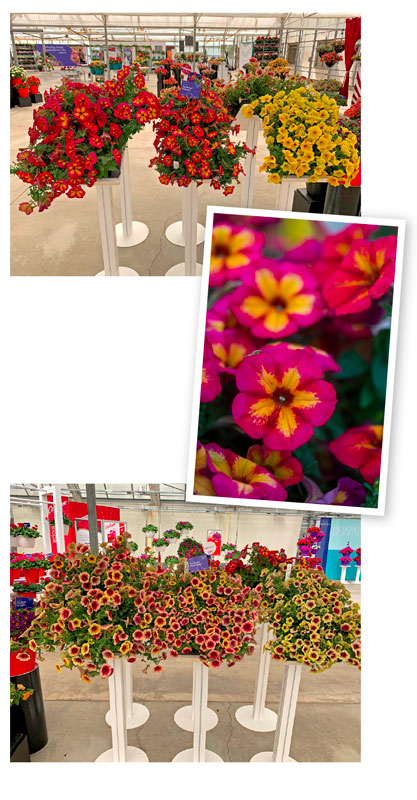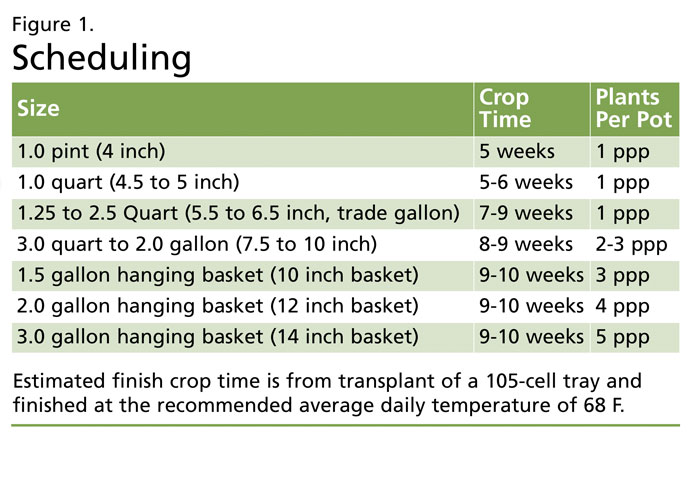10/1/2022
Fun House Petunia Culture
Dr. Alicain Carlson & Dr. Mary Lewis

Fun House Petunia is a collection of petunias where novelty and performance collide to make better retail programs. At CAST 2022, we added Amethyst Sunshine, Papaya and Peach Melba to the collection, offering more dynamic flower colors and patterns. Each variety has a slightly different habit in this collection, but in general, the series has a mounded, trailing habit for a fun addition to hanging basket and patio container programs, and makes a great addition to combos. Potpourri and Peach Melba have unique morphing colors and patterns, depending on plant growth regulators used in finish.
Figure 2, top: Fun House Potpourri Petunia PGR Technical Demonstration at CAST 2022 (seven weeks after transplant). From left to right: Control with no PGRs applied, treated with 2 ppm Bonzi drenches three times and treated with 1,500 ppm B-Nine WSG three times.
Figure 3, middle: Close-up of the bicolor pattern of Fun House Potpourri Petunia.
Figure 4, bottom: Fun House Peach Melba PGR Technical Demonstration at CAST 2022 (seven weeks after transplant). From left to right: Control with no PGRs applied, treated with 2 ppm Bonzi drenches three times and treated with 1,500 ppm B-Nine WSG three times.
Propagation
Stick: Fun House is propagated similarly to other petunias on the market. We recommend sticking cuttings into a 105-cell tray. Bottom heat temperatures should be between 70 to 74F (21 to 23C) for the first three weeks. After roots are well developed, temperatures can be lowered to hold and tone the cuttings. You should see root emergence in six to eight days. Rooting hormone is not recommended.
Irrigation: Mist schedules vary depending on light and temperature conditions. Apply just enough moisture to rehydrate the cuttings and keep them from wilting. Cuttings should be rehydrated within 24 hours after sticking. Cuttings that continue to wilt heavily after 24 hours will callus unevenly and will be delayed in rooting. CapSil (spray adjuvant) can be sprayed on the cuttings at a rate of 2 to 4 oz./100 gal. within one to two days after sticking to aid rehydration. Misting should be significantly reduced after two to three days and after cuttings become fully hydrated. Petunias are particularly sensitive to over-misting, which can lead to chlorotic and deformed foliage and growing tips.
Temperature and light: Day and night temperatures of 72 to 74F (22 to 23C) are recommended. Petunias are facultative long-day plants, so daylength extension lighting up to 14 hours is beneficial, though not necessary. Providing long days in the plug stage can reduce overall time to flower. A light intensity of 1,000 to 1,200 foot candles (200 to 250 micro mols) for the first two weeks after sticking or until root development occurs is recommended. Light levels can be increased up to 3,000 foot candles (600 micro mols) as rooting increases and the cutting matures. Light, in terms of daily light integral (DLI), is ideal at 4 to 6 mols/day for the first two weeks from stick until root development occurs and then it can be increased to greater than 12 mols/day.
Media and nutrition: Begin fertilization at 100 ppm nitrogen when roots become visible. Rates can be increased up to 200 ppm Nitrogen after roots become well developed. Use pri-marily lower ammonium-nitrogen-based Cal-Mag Plus (calcium nitrate + magnesium nitrate) fertilizers in propagation to prevent unwanted stretch. Supplemental feeding with additional iron (i.e., iron chelate) will help prevent iron deficiency and leaf tip chlorosis. Maintain media pH between 5.6 to 6.0 and media EC between 0.9 to 1.3 mS/cm via Saturated Media Extract (SME).
PGRs: All the varieties in the Fun House series have good vigor and generally will need chemical growth regulation in propagation. To control growth after rooting, sprays of B-Nine WSG (2,500 to 3,500 ppm) are effective. A tank-mix spray of Florel (350 ppm) + B-Nine WSG (1,500 ppm) can also be used to control growth and improve branching. Do not spray Florel on stressed or weak cuttings. For all sprays listed above, the mist should be off for a minimum of one hour for the PGR to absorb into the leaf tissue. Pinching is not recommended during propagation. Your liners should be ready to ship and transplant into the finished container in three to three-and-a-half weeks from a 105-cell tray.
In the PGR section for finishing Fun House Potpourri, there are caveats for using B-Nine WSG because it will change the flower color pattern, however, using it during propagation only once will give the plants long enough to grow out of the effects of the PGR in time for finish with a bicolor flower.
Finishing
Transplant and pinch: Transplant plugs directly into the finished container. Place the rooting media slightly below the level of media in the container. (For plants per pot recommendations, see Figure 1.) One pinch is recommended seven to 10 days after transplant for large containers and may not be necessary for small containers, as the Fun House series naturally branches well. A second pinch can be given to plants grown in large baskets and containers, and can be done shortly before a final Bonzi drench.
Temperature and light: Fun House Petunias should be grown at an ADT of 66 to 68F (19 to 20C) with 70 to 72F (21 to 22C) day temperatures and 62 to 64F (17 to 18C) night temperatures. Early morning DIF treatments will help keep plants more compact. Day extension lighting is beneficial to 14 hours, though Fun House will flower readily at 11.5 hour-long natural daylengths. Providing long-day lighting during short days will shorten time to flower and increase flower numbers, as petunias are facultative long-day plants. Aim for light intensities between 4,000 to 6,000 foot candles (800 to 1,200 micro mols) and a DLI of 16 to 18 mols/day. Temperatures can be lowered three weeks after planting and especially towards the end of production to tone or hold the plant. High DLIs and cool finishing temperatures produce high-quality petunias.
Media and nutrition: Media pH of 5.5 to 5.9 and EC of 3.5 to 4.2 mS/cm via pour-thru are optimal. Feed with 200 to 250 ppm Nitrogen. Media should be allowed to dry between irrigations, alternating between moisture level 2 (medium) and 4 (wet). Keep media pH in the mid 5s to avoid iron deficiency and tip chlorosis.
Pests and diseases: Use proper sanitation when pinching or shearing petunias. Petunias and other solanaceous crops are highly susceptible to tobacco mosaic virus (TMV), which can be easily transmitted by mechanical means. Common pests to prevent and scout for are thrips, aphids, budworms, leafminers and whiteflies, and common diseases are Botrytis and powdery mildew.
Color pattern manipulation: Fun House Potpourri’s color and star pattern can be manipulated with PGRs, light intensity and temperature. When managing growth during finish, sprays of B-Nine WSG will turn flowers completely yellow (see Figure 2). The number of B-Nine WSG applications and higher concentrations used will affect how long flowers remain clear yellow and will delay the expression of the bicolor flower pattern. Under average growing conditions, the color change can happen approximately nine weeks after the last B-Nine WSG application. DLIs lower than 10 mols/day will cause flowers that are more muted in color. Color will become more bright and vivid after exposure to higher DLIs. The flower pattern of Fun House Potpourri isn’t influenced by photoperiod. To get the true bicolor pattern (see Figure 3), use Bonzi drenches to control growth in finished production and grow consistently at low night temperatures below 62F (17C). Night temperatures above 66F (19C) will result in nearly all pink flowers.
Similarly, the color of Peach Melba also changes with PGR use. When managing growth during finish, sprays of B-Nine WSG will turn flowers more yellow and reduce the red color intensity (see Figure 4). Amethyst Sunshine and Papaya coloration and pattern are not affected by PGRs.
 General PGR recommendations: It’s best to be proactive in applying PGRs on petunias. Anticipate changes in weather or other conditions that can cause plant stretch and apply PGRs before plant stretch begins. Fun House has good vigor and will generally need chemical growth regulation. Sprays of B-Nine WSG (1,500 to 5,000 ppm) or Sumagic (20 to 30 ppm) can be used to control growth. A tank-mix spray of Florel (350 to 500 ppm) + B-Nine WSG (1,500 to 2,500 ppm) also can be used to control growth and improve branching early in production. Keep in mind the color changing effects of B-Nine WSG outlined in the previous section if choosing this option. A Bonzi drench (2 to 4 ppm) can be applied three to four weeks before finishing and results in toned, high-quality plants. Bonzi drenches (2 to 4 ppm) also can be utilized through production to control growth. Providing cool temperatures, high light and “growing on the dry side” will help keep petunias more compact without reliance on chemistries. Early morning DIF treatments also help.
General PGR recommendations: It’s best to be proactive in applying PGRs on petunias. Anticipate changes in weather or other conditions that can cause plant stretch and apply PGRs before plant stretch begins. Fun House has good vigor and will generally need chemical growth regulation. Sprays of B-Nine WSG (1,500 to 5,000 ppm) or Sumagic (20 to 30 ppm) can be used to control growth. A tank-mix spray of Florel (350 to 500 ppm) + B-Nine WSG (1,500 to 2,500 ppm) also can be used to control growth and improve branching early in production. Keep in mind the color changing effects of B-Nine WSG outlined in the previous section if choosing this option. A Bonzi drench (2 to 4 ppm) can be applied three to four weeks before finishing and results in toned, high-quality plants. Bonzi drenches (2 to 4 ppm) also can be utilized through production to control growth. Providing cool temperatures, high light and “growing on the dry side” will help keep petunias more compact without reliance on chemistries. Early morning DIF treatments also help.
Amethyst Sunshine has a more vigorous, upright habit that we recommend planning in a shear a few weeks after transplant into large containers to encourage more dense branching and prevent lodging when it gets heavy with flowers.
Postharvest
Petunias, in general, are notorious for their flower meltdown at retail due to the stressors of shipping. For best postharvest quality and longevity, apply Chrysal Alesco as flowers first begin to open to help protect plants from ethylene build-up during shipping so they have more color at retail. If two or more weeks will pass between first color and shipping, apply Alesco again one to two days before shipping for maximum protection. Protecting the flowers during shipping also helps to prevent secondary Botrytis infection that’s known to occur on the prematurely senesced flowers of untreated plants. GT
Dr. Alicain Carlson is the Technical Manager and Dr. Mary Lewis is an Associate Breeder for Syngenta Flowers North America.